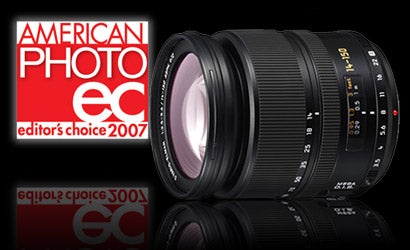Editor’s Choice 2007: SLR Lenses
We may earn revenue from the products available on this page and participate in affiliate programs. Learn more › Click...

We may earn revenue from the products available on this page and participate in affiliate programs. Learn more ›
| Click photo to see images of all the Editor’s Choice 2007 products. |
Despite the popularity of all-purpose zooms, photographers’ interest in lenses is unabated. Lenses are the number-one search item on our Website. And digital photography has brought on a whole new wave of optical innovation.
Lens of the Year: Panasonic Leica D Vario-Elmar 14-150mm f/3.5-4.5 ASPH
Panasonic hasn’t had a new D-SLR since last year’s DMC-L1, but its soon-to-be-released zoom — no bigger, amazingly, than the existing Leica 14-50mm f/2.8-3.5 — is the Four Thirds digital system’s answer to 35mm’s all-in-one 28-300mm zoom. Unlike most of its full-frame counterparts, though, it has built-in optical image stabilization (Panasonic’s Mega O.I.S.), a valuable asset for sharp handheld shooting at its longer focal lengths. With 15 elements, including four aspherics and one ED, the 14-150mm is also the first Leica D lens to incorporate built-in ultrasonic focusing (XSM, for Extra Silent Motor). That aids stealth with the low-profile Panasonic Lumix DMC-L1 or Leica Digilux 3. Close focusing to under 20 inches permits reproduction ratios as high as 1:3. Yet for all its modern advantages, this winning lens has an old-fashioned manual aperture ring.
| American PHOTO Editor’s Choice 2007 | ||
| Intro | Entry-Level DSLRs | Advanced DSLRs | Professional DSLRs | Digital Rangefinders | SLR Lenses | Camera Cellphones | Imaging Software | Fine-Art Printers | Superzoom EVFs | Digital Compacts | Ultrathin Compacts | Storage and Display | Computers | Snapshot Printers | Lighting | Tripods | Camera Bags | Imaging Essentials |
| Click photo to see images of all the Editor’s Choice 2007 products. |
This update of a very affordable zoom for Nikon D-SLRs adds something useful its predecessor lacked: Vibration Reduction (VR). We think VR makes the new lens (the equivalent, in 35mm, of about 80-300mm) much more versatile. Its maximum aperture gets as small as f/5.6 when you set longer focal lengths, forcing you to use slower shutter speeds that might cause blur if VR weren’t constantly compensating. Nikon may be stretching the definition of its pro-level ED glass, but this lens’s image quality is excellent — better at maximum aperture, where you’re most likely to be shooting, than it is when stopped down. All-plastic construction keeps the price low, giving you lots of lens for the money. About $250.
| American PHOTO Editor’s Choice 2007 | ||
| Intro | Entry-Level DSLRs | Advanced DSLRs | Professional DSLRs | Digital Rangefinders | SLR Lenses | Camera Cellphones | Imaging Software | Fine-Art Printers | Superzoom EVFs | Digital Compacts | Ultrathin Compacts | Storage and Display | Computers | Snapshot Printers | Lighting | Tripods | Camera Bags | Imaging Essentials |
| Click photo to see images of all the Editor’s Choice 2007 products. |
We were always willing to trade a stop of speed for a smaller, lighter version of Canon’s bread-and-butter 70-200mm f/2.8 zoom. In fact, the existing EF 70-200mm f/4 has become one of our favorite lenses, and this new version adds Canon’s built-in Image Stabilizer (IS) — greatly mitigating the tradeoff in speed. The f/4 lens’s smaller size makes it easier to hold steady than its f/2.8 counterpart, as well as more transportable for outdoor and travel photography. It’s also the first EF lens to offer an extra stop of stabilized range — four stops total, says Canon, rather than three. Even that one-stop advantage over the f/2.8 version makes up the difference, unless you need a higher shutter speed to capture fast action or want especially shallow depth of field. IS or not, this is one of the sharpest lenses we’ve seen. About $1,060.
| American PHOTO Editor’s Choice 2007 | ||
| Intro | Entry-Level DSLRs | Advanced DSLRs | Professional DSLRs | Digital Rangefinders | SLR Lenses | Camera Cellphones | Imaging Software | Fine-Art Printers | Superzoom EVFs | Digital Compacts | Ultrathin Compacts | Storage and Display | Computers | Snapshot Printers | Lighting | Tripods | Camera Bags | Imaging Essentials |
| Click photo to see images of all the Editor’s Choice 2007 products. |
A 14X focal length range makes this all-purpose zoom the equivalent, when mounted on a D-SLR with an APS-C-sized sensor, of about 28-390mm in 35mm. That’s almost 100mm more magnifying power than 35mm’s popular 28-300mm, and no other SLR lens can match it. More on the order of what you get from Superzoom EVF cameras, its range bests most of them. Put the 18-250mm on a small D-SLR like the Canon Rebel XTi and you get something approaching the compactness of a top EVF model, but with better optics (likely) and a greater degree of photographic control (certainly). In fact, the new lens is virtually the same physical length and diameter as Tamron’s existing 18-200mm Di digital zoom, and focuses to less than 18 inches throughout its range, for a 1:3.5 reproduction ratio at 250mm. About $500.
| American PHOTO Editor’s Choice 2007 | ||
| Intro | Entry-Level DSLRs | Advanced DSLRs | Professional DSLRs | Digital Rangefinders | SLR Lenses | Camera Cellphones | Imaging Software | Fine-Art Printers | Superzoom EVFs | Digital Compacts | Ultrathin Compacts | Storage and Display | Computers | Snapshot Printers | Lighting | Tripods | Camera Bags | Imaging Essentials |
| Click photo to see images of all the Editor’s Choice 2007 products. |
This is the only zoom among Sony’s three new Zeiss lenses for its Alpha 100 D-SLR and the other, higher-end Alpha bodies it has promised. (The others are prime lenses, an 85mm f/1.4 and a 135mm f/1.8.) Its Zeiss optics make it sharp as can be, of course. But we also like its range, the equivalent of 24-120mm in the 35mm format. The extra four millimeters (beyond the usual 28mm) make the lens as useful in shooting cramped interiors, architecture, and expansive landscapes as it is for portraits on its long end. We’d like a wider maximum aperture in the portrait range, but that’s the price of its compactness, and nine aperture blades make out-of-focus areas nice and smooth. About $700.
| American PHOTO Editor’s Choice 2007 | ||
| Intro | Entry-Level DSLRs | Advanced DSLRs | Professional DSLRs | Digital Rangefinders | SLR Lenses | Camera Cellphones | Imaging Software | Fine-Art Printers | Superzoom EVFs | Digital Compacts | Ultrathin Compacts | Storage and Display | Computers | Snapshot Printers | Lighting | Tripods | Camera Bags | Imaging Essentials |
| Click photo to see images of all the Editor’s Choice 2007 products. |
This lens brings a new level of refinement to the curvy distortion of fish-eye photography. Unlike fixed-focal-length fisheyes, it allows you to zoom to control how much of a scene you want to take in, and to tweak a composition when you can’t do so by changing your physical distance. Though the new Tokina’s nominal focal length range is the equivalent, for D-SLRs, of about 15-24mm in 35mm, it actually delivers a full 180-degree angle of view at its short end, narrowing to 100 degrees at the longest. SD glass helps sharpen and downsize the lens by reducing the number of needed elements. About $600.
| American PHOTO Editor’s Choice 2007 | ||
| Intro | Entry-Level DSLRs | Advanced DSLRs | Professional DSLRs | Digital Rangefinders | SLR Lenses | Camera Cellphones | Imaging Software | Fine-Art Printers | Superzoom EVFs | Digital Compacts | Ultrathin Compacts | Storage and Display | Computers | Snapshot Printers | Lighting | Tripods | Camera Bags | Imaging Essentials |
| Click photo to see images of all the Editor’s Choice 2007 products. |
Here’s a lens to match the specs and performance of the top-notch Pentax K10D digital SLR. First in a new series of high-performance DA* lenses that includes a well-matched 50-135mm f/2.8, the 16-50mm produces a focal length range equivalent to 24-75mm in the 35mm format, with the pro plus of an f/2.8 aperture that remains constant throughout its range. Like the K10D, this 15-element ED zoom is tightly sealed against water and dust, and its front element has a special topcoat that repels the elements. Put it on the K10D body and focusing (which goes to less than a foot) defaults to a smooth SDM-assisted AF. About $900.
| American PHOTO Editor’s Choice 2007 | ||
| Intro | Entry-Level DSLRs | Advanced DSLRs | Professional DSLRs | Digital Rangefinders | SLR Lenses | Camera Cellphones | Imaging Software | Fine-Art Printers | Superzoom EVFs | Digital Compacts | Ultrathin Compacts | Storage and Display | Computers | Snapshot Printers | Lighting | Tripods | Camera Bags | Imaging Essentials |
| Click photo to see images of all the Editor’s Choice 2007 products. |
Not just a zoom wannabe, this unique lens is the best of two worlds for rangefinder photographers. It offers three focal lengths in a single lens, selectable with a ring on the barrel, so you don’t have to change lenses on the fly when you’re shooting in the wide-angle range. Yet the focal lengths are all fixed, so you won’t be tempted to cheat your composition by zooming. You’ll have to use your feet instead. Though you get the new lens’s stated focal lengths on a 35mm Leica M — with excellent rectilinear performance throughout — the new lens is really more useful on the new Leica M8 digital rangefinder , on which it gives you the prime equivalents (in 35mm) of about 21mm, 24mm, and 28mm. Rangefinder photography with digital capture and an adjustable wide angle — what more could a modern-day street photographer want? About $3,500.
| American PHOTO Editor’s Choice 2007 | ||
| Intro | Entry-Level DSLRs | Advanced DSLRs | Professional DSLRs | Digital Rangefinders | SLR Lenses | Camera Cellphones | Imaging Software | Fine-Art Printers | Superzoom EVFs | Digital Compacts | Ultrathin Compacts | Storage and Display | Computers | Snapshot Printers | Lighting | Tripods | Camera Bags | Imaging Essentials |
| Click photo to see images of all the Editor’s Choice 2007 products. |
The focal length range on this zoom is more meaningful than it first seems. When used on a digital SLR with an APS-C-sized sensor, it’s the equivalent of about 75-225mm, close to the 70-200mm (or 210mm) long valued for 35mm work. Reflecting its pro caliber, the lens’s maximum aperture remains constant throughout that range, making handheld low-light photographs sharper even when you’re zoomed in to longer focal lengths. Yet the lens is much lighter and smaller than a 70-200mm f/2.8 for full-frame SLRs, so handheld low-light photography is steadier and sharper — aided by the four SLD (Super Low Dispersion) elements that give it its APO designation. Ultrasonic focusing makes AF operation fast and quiet; focusing and zooming are both internal, so the lens doesn’t rotate or change in length. And close focusing of under 40 inches permits reproduction ratios up to 1:5.3. About $650.
| American PHOTO Editor’s Choice 2007 | ||
| Intro | Entry-Level DSLRs | Advanced DSLRs | Professional DSLRs | Digital Rangefinders | SLR Lenses | Camera Cellphones | Imaging Software | Fine-Art Printers | Superzoom EVFs | Digital Compacts | Ultrathin Compacts | Storage and Display | Computers | Snapshot Printers | Lighting | Tripods | Camera Bags | Imaging Essentials |
| Click photo to see images of all the Editor’s Choice 2007 products. |
Something about medium format simply can’t be matched by ever-increasing D-SLR resolution: Because a longer focal length is required for a given angle of view and perspective, you can get shallower depth of field — and beautifully smooth out-of-focus detail — without as much distracting “compression.” The latest in the Lensbaby line lets you capitalize on that quality, adding selective focus control to medium-format shooting with Mamiya 645 (6×4.5cm) and Pentax 67 (6x7cm) SLR bodies. Like the 3G version for 35mm and digital SLRs, this odd but ingenious device has three focusing posts that allow you to lock its flexible bellows tubing into a specific “bend” that puts your sharp spot and out-of-focus areas wherever you want them. (Earlier Lensbaby incarnations required that you hold the bend manually.) Once you’ve found the effect you want, you simply push a button to lock the 3G into position. (You squeeze a pair of knobs to release it.) There’s even a manual collar for fine-tuning focus once you’ve locked it in. About $390.
| American PHOTO Editor’s Choice 2007 | ||
| Intro | Entry-Level DSLRs | Advanced DSLRs | Professional DSLRs | Digital Rangefinders | SLR Lenses | Camera Cellphones | Imaging Software | Fine-Art Printers | Superzoom EVFs | Digital Compacts | Ultrathin Compacts | Storage and Display | Computers | Snapshot Printers | Lighting | Tripods | Camera Bags | Imaging Essentials |

image

image

image

image

image

image

image

image

image

image

image

image